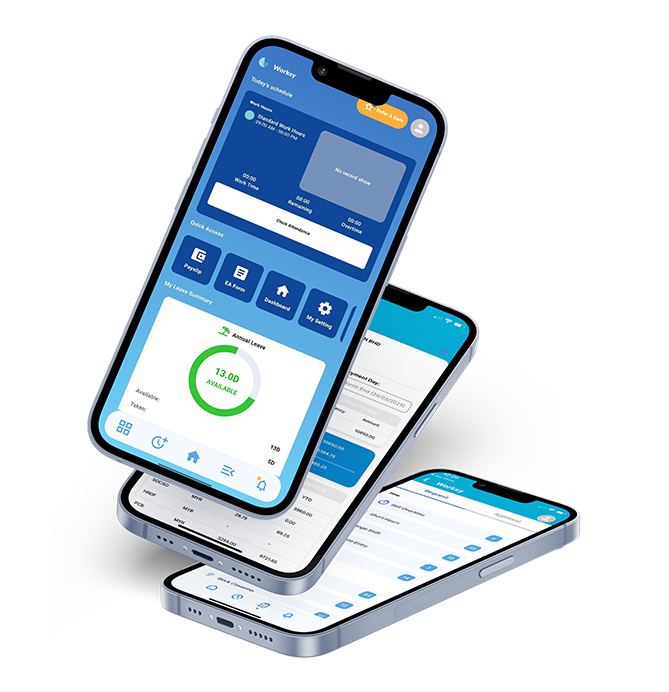scheduled free Worksy HRMS demo.

Employee Financial Wellness: Why It Matters and How HR Can Help
May 20, 2025
Understanding Your Leave Entitlements in Malaysia: A Comprehensive Guide
May 23, 2025Important Updates to Parental Leave in Malaysia.
Understanding and correctly applying parental leave (maternity and paternity leave) policies is vital for HR managers and business owners in Malaysia. Indeed, recent updates, especially through the Employment (Amendment) Act 2022, have significantly changed maternity and paternity leave entitlements. Consequently, staying compliant not only ensures you follow the law but also helps create a supportive work environment. This, in turn, is crucial for employee morale and retention.
This guide offers a clear, complete overview of the current Parental Leave Malaysia laws. Therefore, it will help you understand your obligations and support your employees well. Specifically, we will cover eligibility, duration, allowances, and other important points under the latest labour laws in Malaysia.
Understanding the Latest Changes to Parental Leave Malaysia: Employment (Amendment) Act 2022
The Employment (Amendment) Act 2022, which started on January 1, 2023, introduced several key changes to Parental Leave Malaysia. These changes aim to give better support to working parents. Furthermore, they help align Malaysia with more progressive international standards.
Key updates include a longer paid maternity leave and the official introduction of paid paternity leave for eligible employees. Importantly, these changes apply to employees covered under the Employment Act 1955. For businesses, this means you need to update your internal HR policies. Additionally, ensure your HR systems can manage compliance with these new Parental Leave Malaysia rules.
Maternity Leave in Malaysia: A Comprehensive Guide to Your Entitlements
What is Maternity Leave in Malaysia?
Maternity leave is a legally required period of paid time off for female employees before and after childbirth. Primarily, its purpose is to allow mothers to recover from childbirth and care for their newborn. In Malaysia, the Employment Act 1955 mainly governs maternity leave in Malaysia.

Join 3,000+ Malaysian companies using Worksy for HR automation.
Request free demo now*Terms and conditions apply.
Key Legal Provision for Maternity Leave in Malaysia: Section 37 of the Employment Act 1955
Section 37 of the Employment Act 1955 is the foundation of maternity protection in Malaysia. Specifically, it details the rights to maternity leave, maternity allowance, and protection against job termination due to pregnancy. Therefore, employers must know this section well to ensure they comply with maternity leave in Malaysia regulations.
Duration of Maternity Leave in Malaysia: Is 98 Days Compulsory?
Yes, under the latest amendments, eligible female employees are entitled to 98 consecutive days of paid maternity leave in Malaysia. Employers must provide this.
- Commencement: An employee can start her maternity leave anytime from 30 days before her expected due date, or on the day right after her confinement, if she has told her employer. If she starts earlier than 30 days before confinement but still works during this period, her leave has not officially begun.
- Calculation: Maternity leave includes consecutive calendar days, which means rest days and public holidays count towards the 98 days.
Eligibility Criteria for Maternity Leave in Malaysia
To qualify for paid maternity leave in Malaysia and allowance, a female employee must meet these conditions:
- She must have worked for the employer for at least ninety days in total during the nine months right before her confinement.
- She must have worked for the employer at some point in the four months right before her confinement.
- She must have no more than five living children at the time of confinement to receive the maternity allowance from her employer. However, she still gets the 98 days of leave, regardless of the number of children.
These rules apply to female employees covered by the Employment Act 1955 when considering maternity leave in Malaysia.
Maternity Allowance in Malaysia
- Calculation: Eligible female employees receive a maternity allowance equal to their ordinary daily pay, or a rate set by the Minister (whichever is higher), for each day of the 98-day maternity leave. In essence, this means full pay during maternity leave for those who qualify. Accurate preparation of employee payslips during this time is very important.
- Payer: The employer pays the maternity allowance.
- Conditions for Receiving Allowance: Besides meeting eligibility, the employee must inform her employer about her pregnancy and planned leave. Also, she must not work for any other employer during her maternity leave.
Notification and Application Process for Maternity Leave in Malaysia
- Employee’s Responsibility: A female employee must tell her employer about her expected due date and her plan to take maternity leave at least 60 days before her expected delivery. If she fails to do this without a good reason, her maternity allowance payment might be paused until she informs her employer.
- Required Documentation: Employers can ask for a medical certificate from a registered doctor confirming the pregnancy and expected delivery date.
Protection Against Termination for Pregnant Employees in Malaysia
The Employment Act 1955 offers significant protection for pregnant employees concerning Parental Leave Malaysia:
- An employer cannot fire a female employee during her pregnancy or maternity leave if the reason for firing is her pregnancy or confinement.
- If an employer fires a female employee who is pregnant or on maternity leave for reasons other than her pregnancy (like misconduct or redundancy), the employer must prove the termination was not due to pregnancy or confinement.
- An employer cannot give a termination notice to a female employee who is pregnant or ill due to her pregnancy if her absence from work is not more than 90 days in total during her pregnancy (not including maternity leave).
Can an Employee Resign During Maternity Leave in Malaysia?
Yes, an employee can resign while on maternity leave in Malaysia. Standard resignation procedures apply, including giving the contractual notice period.
- If an employee resigns without giving proper notice, the employer may deduct payment instead of notice from any salary owed.
- It is important to handle these situations professionally. For instance, you might discuss annual leave encashment if applicable upon resignation.
Provisions for Miscarriage or Stillbirth under Maternity Leave in Malaysia
If an employee has a miscarriage after at least 22 weeks of pregnancy (stillbirth), she is entitled to the full 98 days of maternity leave in Malaysia and allowance, provided she meets the eligibility criteria. However, if the miscarriage happens before 22 weeks of pregnancy, she is not entitled to maternity leave but can take sick leave if a doctor certifies it.
Extending Maternity Leave in Malaysia: Unpaid Options
The Employment Act 1955 does not automatically provide for unpaid maternity leave beyond the 98 paid days. Therefore, any extension of leave as unpaid leave depends on an agreement between the employer and employee. Employers might have their own internal policies for extended unpaid parental leave.
Paternity Leave in Malaysia: What Employers Need to Know
Introduction to Paternity Leave in Malaysia
The Employment (Amendment) Act 2022 officially introduced and mandated paid paternity leave in Malaysia for eligible male employees in the private sector. This is a major step towards supporting fathers in their parenting roles and an important part of Parental Leave Malaysia.
Duration of Paternity Leave in Malaysia
Eligible male employees can take 7 consecutive days of paid paternity leave in Malaysia for each birth. This is available for up to five births, no matter how many spouses the employee has.
Eligibility Criteria for Paternity Leave in Malaysia
To qualify for paid paternity leave in Malaysia, a male employee must:
- Be married to the child’s mother.
- Have worked for the same employer for at least 12 months immediately before starting the leave.
- Inform his employer about his wife’s pregnancy and his plan to take paternity leave at least 30 days before the expected birth or as soon as possible after the birth.
Is Paternity Leave in Malaysia Paid?
Yes, the 7 consecutive days of paternity leave in Malaysia are paid at the employee’s ordinary rate of pay.
Notification and Application Process for Paternity Leave in Malaysia
- Employee’s Responsibility: The employee must tell his employer about his wife’s pregnancy and his plan to take paternity leave. Ideally, he should do this 30 days before the expected birth or as soon as he can after the birth.
- When Leave Can Be Taken: The employee must take the leave as a continuous block of 7 days. Typically, it can start from the child’s birth date or shortly after, as agreed with the employer.
- Required Documentation: Employers can ask for supporting documents, such as a marriage certificate and the child’s birth certificate.
Employer Obligations and Best Practices for Parental Leave Malaysia
Calculating Parental Leave Malaysia Days Correctly
- Maternity Leave: 98 consecutive calendar days.
- Paternity Leave: 7 consecutive calendar days.
Using an eLeave management system can help accurately track and calculate these Parental Leave Malaysia types.
Record-Keeping Requirements for Parental Leave Malaysia
Employers must keep proper records of all maternity and paternity leave taken by their employees. These records should include dates and any allowance paid. Consequently, these records are essential for compliance and audits related to maternity and paternity leave in Malaysia.
Impact of Parental Leave Malaysia on Other Leave Entitlements
Generally, parental leave (maternity or paternity) does not break an employee’s continuity of service. Employees usually continue to accrue employee benefits like annual leave during paid parental leave. However, company policies should clearly state this. Sick leave is separate and used for personal illness.
Communicating Parental Leave Malaysia Policies
You should develop clear, written Parental Leave Malaysia policies that all employees can easily access. These policies should detail:
- Eligibility criteria.
- Leave duration and pay.
- Application procedures.
- Employee rights and protections.
Clearly communicating these policies is a key part of good HR management.
Penalties for Non-Compliance with Parental Leave Malaysia
Failing to follow the Parental Leave Malaysia provisions under the Employment Act 1955 can lead to penalties, including fines. Thus, ensuring compliance is not just about avoiding penalties; it is also about maintaining ethical employment practices.
Frequently Asked Questions (FAQ) about Parental Leave Malaysia
What is the new maternity law in Malaysia regarding Parental Leave Malaysia?
The new maternity law, effective January 1, 2023, under the Employment (Amendment) Act 2022, extends paid maternity leave to 98 consecutive days for eligible employees. Additionally, it strengthens protections against termination due to pregnancy as part of Parental Leave Malaysia.
How much is maternity allowance in Malaysia under Parental Leave Malaysia?
Eligible female employees receive a maternity allowance equal to their ordinary rate of pay (full pay) for each day of the 98-day maternity leave period. The employer pays this. However, this allowance is subject to the employee having no more than five surviving children.
What’s the longest period one can take for maternity leave (including unpaid) as part of Parental Leave Malaysia?
The statutory paid maternity leave is 98 consecutive days. Any extension beyond this as unpaid leave requires agreement between the employer and employee; it is not a statutory right under Parental Leave Malaysia.
Can an employer terminate a pregnant employee in Malaysia according to Parental Leave Malaysia laws?
No, an employer cannot fire a female employee specifically because she is pregnant or while she is on maternity leave. An exception exists if the termination is for reasons unrelated to pregnancy (e.g., proven misconduct, redundancy), and the employer can prove this.
Who is eligible for paternity leave in Malaysia under Parental Leave Malaysia?
A male employee qualifies for 7 days of paid paternity leave if he is married to the mother, has worked for the same employer for at least 12 months before the leave, and informs the employer appropriately. This is limited to five confinements.
Conclusion: Embracing Enhanced Parental Leave Malaysia
The recent changes to Malaysia’s Employment Act have notably improved parental leave benefits. This reflects a growing understanding of how important it is to support working parents. For HR managers and business owners, keeping up with these changes—from the 98-day maternity leave to the 7-day paid paternity leave—is essential for managing Parental Leave Malaysia effectively.
By ensuring full compliance, providing clear communication, and creating a supportive environment, businesses can meet their legal duties. Moreover, they can also boost employee loyalty, productivity, and overall workplace well-being. We recommend you review and update your internal HR policies and employee handbooks to include these latest Parental Leave Malaysia provisions.
Disclaimer: This article provides general information and should not replace legal advice. Employers should consult with legal professionals or refer to the latest official government gazettes for specific guidance on employment laws in Malaysia.

Tired of HR chaos? Let Worksy simplify your workflow.
Request free demo now*Terms and conditions apply.


